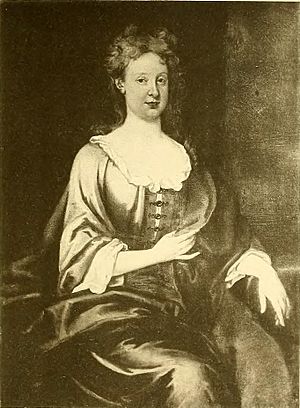William Johnstone, 1st Marquess of Annandale facts for kids
William Johnstone, 1st Marquess of Annandale (born February 17, 1664 – died January 14, 1721) was an important Scottish nobleman. He inherited the titles of Earl of Annandale and Hartfell when his father passed away in 1672. William Johnstone played a big part in Scottish politics during a time of many changes.
Contents
Early Life and Political Start
William Johnstone was the son of James Johnstone, 1st Earl of Annandale and Hartfell, and Henrietta Douglas. He became the Earl of Annandale and Hartfell at a young age.
At first, he supported James Scott, the Duke of Monmouth. He also seemed to support the "Revolution" that changed who was king. However, he later joined a group called "The Club." This group included people who supported the old royal family, known as Jacobites. Because of this, he was put in prison for a short time. This was connected to something called the Montgomery plot.
Rising in Power
After confessing and explaining his actions, William Johnstone was forgiven. He quickly regained favor with the government. In 1693, he was made an Extraordinary Lord of Session, which meant he was a special judge. He also became a Lord of the Treasury, helping to manage Scotland's money. He even received a special payment for his help in an investigation about the Glencoe Massacre.
His influence continued to grow. In 1701, he was given the higher title of Marquess of Annandale. This made him one of the most important nobles in Scotland. He also served as the Lord High Commissioner to the General Assembly of the Church of Scotland in 1701 and 1711. This role meant he represented the King in the Church's main meeting.
William Johnstone held other key positions too:
- Keeper of the Privy Seal of Scotland in 1702. This person was in charge of the King's private seal, used for important documents.
- President of the Privy Council of Scotland for several periods (1692–1695, 1702–1704, and 1705–1706). The Privy Council was a group of advisors to the monarch.
- He became a Knight of the Thistle in 1704, which is a very high honor in Scotland.
- He was also a joint Secretary of State for Scotland from March to September 1705. This was a powerful role in the government.
Views on the Union
William Johnstone was against the Union between Scotland and England. This Union created Great Britain. Even though he opposed it, he later served as a representative peer from 1709 to 1713. This meant he was one of the Scottish nobles who sat in the British Parliament. From 1714 to 1716, he was the Keeper of the Great Seal of Scotland. This person was in charge of the official seal used for the most important government papers.
Family Life
William Johnstone was married twice. His first marriage was on January 1, 1682, to Sophia Fairholme. She was the daughter of John Fairholme of Craigiehall. His second marriage was on November 20, 1718, to Charlotte Van Lore Bempde. She was the daughter of John Vanden Bempde of Hackness.
Children from First Marriage
William and Sophia Fairholme had five children:
- Lady Henrietta Johnstone (born November 11, 1682 – died November 25, 1750). She married Charles Hope, 1st Earl of Hopetoun.
- Mary Johnstone (born June 15, 1686 – died as a baby).
- James Johnstone, 2nd Marquess of Annandale (1687 – February 21, 1730). He never married.
- John Johnstone (born 1688 – died young).
- William Johnstone (1696 – December 24, 1721).
Children from Second Marriage
William and Charlotte Van Lore Bempde had two children:
- George Johnstone, 3rd Marquess of Annandale (born May 29, 1720 – died April 29, 1792). He never married.
- John Johnstone (born June 8, 1721 – died October 1742). He married Mary Beddoe of Ludlow.



